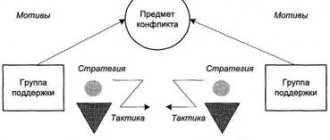Adviсe
- Difficulties and types of communication barriers
- Semantic barrier
- Logical barrier
- Phonetic barrier
- Modality barrier
- Personal barrier
- Motivational barrier
- Barrier of incompetence
- Ethical barrier
- Communication style barrier
- Aesthetic barrier
- Social barrier
- Barrier of negative emotions
- Installation barrier
- Double barrier
- Barrier to Rudeness
- Barrier of inability to hear and listen to the interlocutor
Communication is such a familiar category of people’s existence in society that we simply stop noticing it. Without communication, a person, and not only a person (any living creature living in a particular society) cannot imagine himself. People communicate at home, on the street, in transport, at work, etc. We are accustomed to hearing speech and understanding it, and if we don’t understand it, then we learn the language and understand the interlocutor. However, it is not so much language barriers that become an obstacle to communication between people; there are psychological barriers to communication. You can “cross” them yourself, you just need to know how to do it right.
Difficulties and types of communication barriers
Have you ever talked to someone who clearly doesn't want to talk to you? It’s not clear why, there is an invisible wall between you and him, through which not only no information comes from him, but, as it seems to you, he understands little of your speech. It is this invisible barrier that is called a barrier to communication in psychology. There are many sources for this reason:
Person's character; Upbringing; The level of education; Age; Status in society; The current situation and more.
It should be noted with confidence that every person living on planet Earth has encountered this problem.
In the process of communication, the reasons that put a barrier between people can be conscious or unconscious. Conscious reasons are those that a person can explain to himself and his interlocutor. Unconscious, when people cannot understand and explain the origins of communication disorders. It is especially difficult to establish contact if both partners have communication difficulties.
So, what types of barriers does psychology divide communication into?
Communication barriers: how to recognize and overcome them
Communication in communication is, first of all, influence: if communication is successful, there is a change in the ideas about the world of the person to whom it is addressed. A communication barrier is a psychological obstacle to adequate information between communication partners. What are these barriers and how to overcome them?
Analyzing the communication process, we are convinced at every step that communication is communication, i.e. exchange of opinions, experiences, considerations, moods, desires, etc. In other words, this side of communication is usually understood as the process of information exchange. In fact, information is not only transmitted, but also formed, clarified, and developed.
This second side of communication has its own characteristics, namely:
- the content of a specific communication can be extremely diverse: from a conversation between three-year-old children to a conversation between specialists at a scientific symposium;
- the effectiveness of communication is associated primarily with this function;
- communication in communication is always significant for its participants, because the exchange of information does not happen “just like that”, but in order to achieve some goals, satisfy some needs;
- communication in communication is, first of all, influence: if communication is successful, there is a change in the ideas about the world of the person to whom it is addressed.
In the process of communication, difficulties and misunderstandings often arise. They may be caused by communication barriers that arise in the process of managerial communication.
Speech, any kind of information has always been and is a way of suggesting something . However, we often witness counter psychological activity called counter-suggestion , i.e. a person seems to be protecting himself from the inexorable effect of another person’s speech.
The counter-suggestion mechanism erects numerous communication barriers to the flow of information. Thus, a communication barrier is a psychological obstacle to adequate information between communication partners. What are these barriers and how to overcome them?
In the process of business communication, at least three communication barriers and their various modifications may arise:
- "authority";
- "avoidance";
- "misunderstanding".
The first two provide protection from the source of information, the last - protection from the message itself.
Communication barrier “authority”
Having divided all people into authoritative and non-authoritative, a person trusts only the former and refuses to trust others. Thus, trust and distrust are, as it were, personified and depend not on the characteristics of the information being transmitted, but on who is speaking. For example, older people do not listen well to the advice of young people.
Classifying a person as authoritative depends on the following factors:
- social position (status), from belonging to a real “authoritative” group. Psychologist P. Wilson showed students in different college classes the same man. In one class, the psychologist presented this man as a student, in the second - as a laboratory assistant, in the third - as a teacher, in the fourth - as an assistant professor, in the last - as a professor. After the guest left, the students were asked to determine as accurately as possible his height and the height of the experimenter himself. It turned out that the stranger's height steadily increased as his social status increased, while the psychologist's height did not change. Interestingly, the difference in the height of the stranger from the first to the last class was 14-15 cm;
- attractive appearance (is the hair neat, combed, ironed, shaved, buttoned up, etc.);
- a friendly attitude towards the recipient of the influence (smile, friendliness, ease of use, etc.);
- competence;
- sincerity, and if the listener trusts the speaker, then he perceives and remembers the conclusions very well and practically does not pay attention to the course of reasoning. If there is less trust, then he is cooler about conclusions, but is very attentive to the arguments and the course of reasoning.
Communication barrier "avoidance"
A person avoids sources of influence, avoids contact with the interlocutor. If it is impossible to evade, then he makes every effort not to perceive the message (inattentive, does not listen, does not look at the interlocutor, uses any excuse to end the conversation). Sometimes they avoid not only sources of information, but also certain situations (for example, the desire to close their eyes when watching “scary places” from horror films).
More on the blog: About equality
How to overcome this barrier? It has been established that most often the barrier is caused by one degree or another of inattention. Therefore, only by controlling the attention of the interlocutor, the audience, can this barrier be overcome. The main thing is to solve two interrelated problems:
- attract attention;
- keep attention.
Our attention is most influenced by the following factors: the relevance and importance of information, its novelty, non-standard presentation, surprise, the intensity of information transmission, the sonority of the voice and its modulation.
You can attract attention using three basic techniques. These include:
- "neutral phrase" technique. At the beginning of a speech or conversation, a phrase is pronounced that is not directly related to the main topic, but certainly for some reason has meaning, significance, value for the interlocutor or for everyone present (where you come from, the last movie you watched, television show, book you read, hobbies and etc.);
- “enticement” technique. The speaker says something that is difficult to understand, such as speaking very quietly, monotonously, or unintelligibly, and the listener has to make special efforts to understand anything. These efforts require concentration. As a result, the speaker seems to “lure” the listener into his “net.” In other words, the speaker provokes the listener to use methods of concentration, and then uses them;
- receiving eye contact. The speaker looks around the audience, looks closely at someone, selects several people in the audience and nods to them, etc.
No less important is the problem of maintaining attention. It can be solved in a number of ways. The most important of them are the following:
- “isolation” technique: when they take the interlocutor aside, seclude themselves, close the doors and windows in lecture halls, and make comments to the speaker. This is why the speaker disturbs the lecturer more than the sleeper;
- the technique of “imposing rhythm”: constant change in the characteristics of voice and speech, i.e. By speaking now louder, now quieter, now faster, now slower, now expressively, “with pressure,” now in a tongue twister, now neutrally, the speaker seems to impose his sequence of switching attention on the interlocutor. This technique eliminates the monotony of sound;
- “emphasis” technique: the use of various official phrases designed to attract attention, such as “Please pay attention,” “Important about, etc.
Communication barrier "misunderstanding"
Often the source of information is trustworthy and authoritative, but the information “does not reach” (we do not hear, we do not see, we do not understand). Why does this happen and how can these problems be solved?
Usually there are four barriers of misunderstanding: phonetic (phoneme - sound), semantic (semantics - the semantic meaning of words), stylistic (stylistics - style of presentation, correspondence of form and content), logical.
3.1. Phonetic barrier of misunderstanding
Occurs in the following cases:
- when speaking a foreign language;
- use a large number of foreign words or special terminology;
- when they speak quickly, slurredly and with an accent.
To overcome the phonetic barrier, you need:
- intelligible, legible and loud enough speech, without tongue twister;
- taking into account the audience and individual characteristics of people (the less a person knows the subject of discussion, the slower one must speak, the more detailed one must explain; people of different nationalities speak at different speeds: in the north and in the middle zone - slower, in the south - faster; small children and old people do not perceive fast speech well, etc.);
- availability of feedback from the interlocutor and the audience.
3.2. Semantic barrier of misunderstanding
It occurs when the language is phonetically “ours”, but the meaning conveyed is “foreign”. This is possible for the following reasons:
- any word usually has not one, but several meanings;
- “semantic” fields are different for different people;
- Often slang words, secret languages, frequently used images and examples in any group are used (for example, the meaning of the words “feather”, “cabbage”, etc. in thieves’ jargon differs significantly from the true meaning).
The emergence of a barrier can be explained as follows: we usually proceed from the fact that “everyone understands as I do,” while it would be more correct to say the opposite - “everyone understands in their own way.”
To overcome the semantic barrier it is necessary:
- speak as simply as possible;
- agree in advance on the same understanding of some key words, concepts, terms, if you need to clarify them at the beginning of the conversation.
More on the blog: 5 ways to get inspired
3.3. Stylistic barrier of misunderstanding
It occurs when a person is obliged to understand and reflect in some answer or action only that verbal address that is subject to the established grammatical structure. Otherwise, when there is a discrepancy between form and content, a stylistic barrier arises.
In other words, if the style of presentation is too heavy, too light, in general, does not correspond to the content, then the listener does not understand it or refuses, does not want to understand. The main thing when overcoming the stylistic barrier is to correctly structure the transmitted information.
There are two basic rules for structuring information in communication: the rule of the frame and the rule of the chain.
The frame rule is based on the action of the psychological law of memory, discovered by the German psychologist G. Ebbinghaus (this law is often called the “series factor”). Its essence is that the beginning and end of any information series, no matter what it consists of, is retained in human memory better than the middle.
The frame in communication is created by the beginning and end of the conversation. For the effectiveness of communication, the upcoming conversation, it is advisable to first indicate the goal, prospects and expected results of communication, and at the end of the conversation - to summarize, show a retrospective and note the degree of achievement of goals. Moreover, in initial communication, the most important part is the beginning, and in repeated business communication, the most important part is the end of the conversation. In the second case, people are not as interested in how the negotiations or conversation went, as in how they ended.
The chain rule is based on the assumption that the content of communication cannot be a shapeless pile of various information, it must somehow be built, connected into a chain, “listed.” Any chain, arranging, connecting, organizing the content, like a frame, performs two tasks at once: firstly, it allows you to improve memorization, and secondly, it helps to structure information in accordance with the expectations of the interlocutor.
The following transfer options are possible:
- simple enumeration - “firstly, secondly, thirdly...”;
- ranking - “first about the main thing, now about the constituent elements, and finally, the less significant...”;
- logical chain - “if this is then, then we can assume that..., and therefore...”. The logical construction of the message should lead the interlocutor from drawing attention to interest, from interest to the main provisions, from the main provisions to objections and questions, from objections and questions to the conclusion, and from the conclusion to a call to action.
3.4. Barrier of logical misunderstanding
It occurs if a person, from our point of view, says or does something contrary to the rules of logic. Then we not only refuse to understand him, but also emotionally perceive his words negatively. At the same time, we implicitly assume that there is only one logic - correct, i.e. our.
Each person thinks, lives and acts according to his own logic, but in communication, unless these logics are correlated or if a person does not have a clear idea of his partner’s logic, a barrier of logical misunderstanding arises.
Overcoming a logical barrier is possible if the following conditions are met:
- taking into account the logic and life position of the interlocutor. To do this, it is necessary to roughly imagine the position of the partner, the interlocutor (who he is, what positions he stands in, etc.), as well as individual and social-role characteristics, since the acceptability or unacceptability of a particular logic for a partner mainly depends on his initial orientation ;
- correct argumentation.
Thus, barriers to communication are not the result of a conscious, voluntary and targeted defense against the effects of information. Their action is contradictory.
The barrier system is like an automated security system: when a security alarm is triggered, approaches to a person are automatically blocked; otherwise the human brain and psyche could be traumatized by the content or volume of information.
However, sometimes barriers also play a negative role. For example, difficultly presented but necessary information is not perceived or is perceived with distortions and incompletely. A person who knows the solution but lacks authority may not be heard. This contradiction can be resolved by knowledge of the socio-psychological characteristics of the listed barriers and ways to overcome them.
Author: Igor Nikolaevich Kyznetsov, image consultant, author of training programs on business communication and corporate culture.
Source
Semantic barrier
A similar barrier arises from different interpretations of words and concepts with which the interlocutor operates. This is the most common barrier, because for all people the same things are interpreted differently. For one man, the best wife is a housewife, the mother of his children, smart and beautiful, and for the second, she is the one who does not contradict him and silently sits at home with the children, without the right to vote. Therefore, the statement from men that all women are the same sounds differently. They say the same phrase, but it sounds different for everyone. Realizing that they have not found a common direction in the conversation, the interlocutors face a barrier on the path to mutual understanding and agreement. To overcome this particular barrier, the interlocutors must have an idea of the world and life in which the opponent lives. You need to know the interlocutor’s turns of speech, his manner of expressing thoughts, so that there are no discrepancies in the spoken phrases. If you see that your interlocutor is confused, trying to decipher the thought that you put into this or that phrase, take your time, stop your monologue, and explain to your partner what you meant. Decipher the words and concepts that most people use in order to convey the idea to your interlocutor as clearly as possible.
How to overcome?
I described in detail the main ways in which it is possible to establish communication in an article on the development of communication skills. Here I will add a little directly about how to overcome the obstacles that have arisen.
- Don't be afraid to be why. If something is not entirely clear or illogical to you, ask a question. Remember, everyone has different concepts of the simplest things? Also keep track of how easy you are to understand. If you formulate overly complex sentences, just think about why you need to be confusing and difficult for others to understand? What does this give you? Please clarify whether you are understood at the moment? When asking questions, add that you want to hear him correctly, so you ask again.
- If semantics and slang are different, use the same words and expressions; this technique will help to establish contact and win you over.
- If you notice obstacles on the part of your interlocutor, use the active listening technique, which I wrote about in this article.
- Train your empathy and learn to accept otherness. For many, it is important to simply feel support and acceptance, and not advice or recommendations for action. The ability to empathize and put yourself in the place of another greatly simplifies the process of interaction. Respect the opinion of another person, it has the right to be, because in the same situation everyone has their own truth.
- Don't expect much from your partners, and also allow yourself to be yourself. After all, the fear of not meeting expectations provokes anger and anxiety, which subsequently causes disappointment, and all these feelings do not at all contribute to lively and close relationships.
- When receiving information, one should sometimes make distinctions, that is, separate emotions from facts, leaving emotions and evaluation aside, then it is possible to achieve objectivity and a correct interpretation of what was said.
- Regarding modality, address your partner depending on his type, for example: “listen”, “look”, “do you feel?”. It’s not difficult to understand his affiliation, just listen carefully to what words he uses most often in his speech and what he pays more attention to.
Logical barrier
A logical obstacle in a conversation is the inability to formulate phrases and then express them through verbal communication. These are people who cannot find the words to express a certain situation or are unable to cope with the flow of thoughts and emotions flying through their brain. The reasons for such manifestations may be the following factors:
Lack of education; Stiffness and shyness.
When faced with such a person, be patient, listen to him with Olympian calm, and ask. Only in this case will you be able to wait for the “rational grain” of everything you hear. If you are such a person yourself, follow these rules:
Listen carefully to those people who know how to speak beautifully. Surely, among your friends there are such people; Buy educational literature. This could be a textbook on logic or a master class on the art of public speaking; Take a public speaking course.
Ask your friends to help you overcome the logic barrier through “feedback” and their recommendations.
Ways to calculate barrier type
You need to analyze your experiences and your partner’s reactions. Communication barriers are associated not with the content of the dialogue, but with the features of speech: the logic of the narrative, vocabulary, clarity of pronunciation of words.
Interaction barriers arise during communication. In this case, one of the parties is not satisfied with the moral character, level of knowledge and character of the partner. Barriers to perception – stereotypes, expectations. If a psychological barrier arose too quickly or even before communication, it is a barrier of perception.
Visually, the tension between the companions is manifested through body language. Pay attention to:
- facial expressions (tense face, smile does not match the expression of the eyes);
- posture (closed posture - the companion turns away, crosses his limbs; excessive relaxation and absent-mindedness are also considered signs of psychological closedness);
- gesticulation (sudden movements; involuntarily clenched fists);
- expression of the eyes (absent, “running” or long gaze).
READ Meeting the parents of the bride and groom: how to make a lasting impression
Phonetic barrier
This expression of one’s thoughts is not accurate and is not clear to the opponent. This makes it very difficult to perceive the information you convey. If you suspect that your speaking technique is not professional enough, but you need to keep the attention of your interlocutor at all costs, there are several recommendations:
Barriers in business communication can be overcome in the following way: listen to your interlocutor and adapt to his manner of expressing thoughts and speaking. It will be especially kind of you to ask questions about the topic of the conversation; It is easier to overcome barriers in informal communication - you explain to your interlocutor that you do not understand him, and together you look for a way out of the situation. You just need to do this very gently and tactfully so as not to offend the person.
Cultural barrier
When communication occurs between representatives of different cultures, the likelihood of a cultural barrier occurring is high. But cultural differences are manifested not only in communication with foreigners or representatives of other faiths.
Problem
Incorrect communication with a person of a different nationality or religion may offend his beliefs. Stories about Friday night parties can ruin the mood of a person for whom alcohol is contraindicated. Trying to explain to an older person the meaning of a popular YouTube video may be met with misunderstanding.
Solution
Try to study the interlocutor in advance and conduct the conversation as tactfully as possible. If there is a high risk of blurting out something wrong, try to explain to your interlocutor face to face that you are not too familiar with his culture.
Modality barrier
A person is able to perceive the world around him using five senses:
Vision; Hearing; Smell; Touch; Taste.
However, for each person there is a priority organ, based on the perception of which we draw our own picture of the world. This is called modality. A person with an auditory modality perceives visual or tactile information with a lesser degree of intelligibility. To determine the modality of your interlocutor, show him photographs, graphs, turn on audio recordings or videos, touch. Reinforce each action with appropriate verbs: see, hear, feel, etc.
Gender barrier
The reason for misunderstanding may be differences in communication and thinking between men and women. Women tend to think intuitively, while men tend to think logically. Thus, women like to talk about people and emotions, while men focus on something physical and measurable. These stereotypes, of course, do not apply to everyone.
Problem
What is acceptable with a man may be unethical with a woman. A male boss may be skeptical of women's professional skills, allowing stereotypes to interfere with communication. This way, he risks not only offending his interlocutors, but also misassessing the work situation.
This effect also works in the opposite direction: the attitude towards the words of a charming woman may be unfairly inflated.
Personal barrier
A personal barrier is placed between people if one of the interlocutors, for a certain reason, does not like the other. However, some people are more tolerant of the shortcomings of others, so it is easier for them to overcome their feelings of hostility. Otherwise, communication between people becomes impossible. This comes from the lack of self-control of someone who cannot stop in their feelings of discomfort or has those shortcomings that irritate the interlocutor: slowness, bad manners, fussiness, etc. Do not hesitate to be considered an ignoramus; tell your interlocutor what irritates you so much in his behavior. However, do not forget that we are all not without shortcomings, so control yourself.
Difficulties in communication and life situation
However, everything depends not only on the personality and character of a person. There are situations in which almost all of us become uncomfortable. This is reflected in all our behavior, including communication with other people. In this case, the barrier is the situation that caused discomfort and its characteristics.
Finding yourself in such circumstances, all participants in communication feel uncomfortable. Some people are aware of this to a greater extent, and others to a lesser extent. At the same time, they do not just feel it - by accident or on purpose they prevent each other from satisfying their desires and achieving the goals of communication. As a result of this, everyone is worried, angry, does not understand each other, and is generally tense. Most often this happens in situations of restriction, refusal, blame and insult (which, in general, is not surprising).
On the one hand, collective memory takes its toll. Humanity in general and the inhabitants of Russia in particular have repeatedly experienced suppression, repression, war, and famine. Therefore, insults, accusations, restrictions and refusals are very clearly imprinted in the minds of people, who subsequently use them more and more often to resolve conflicts, overcome obstacles, gain power and even seek happiness. This is becoming a typical way for an entire nation to react, globally speaking.
On the other hand, having such a negative memory becomes unnecessary when we have such a rich culture of aggression. Probably, each of you will agree that in modern society a lot of attention is paid to aggression. All kinds of media are especially guilty of this - television, newspapers, magazines, the Internet, advertising companies. The culture of aggression is also becoming increasingly popular due to some features of our life: overcrowding in schools, hospitals and prisons, high unemployment, low qualifications of people working with the population, low salaries and lack of career prospects, corruption, poor quality of government and much more, about which you know firsthand. You all face this and know that these situations are always fraught with barriers to communication.
Motivational barrier
This barrier occurs in cases where people have different motives for entering into a conversation. For example, you want to talk with your husband about going on vacation, and he wants to discuss with you the problem of buying a new car. In this case, people will not only not understand each other, it can lead to conflict in the family. In order to avoid troubles, before starting a conversation, voice the topic you want to talk about.
Perceptual barrier
Perceptual barrier - barrier of perception. The mood in which we are spoken to directly affects the effectiveness of communication.
Problem
An indifferent tone and disinterest conveyed by body language make the interlocutor skeptical about the success of the conversation and discourage him from having a conversation with you. The same goes for people who explain their point of view without respect or with hard-to-conceal or not-at-all hostility.
Solution
Start the conversation on a positive note and try to maintain it throughout the conversation. Use appropriate gestures, smile, and remember to make eye contact with your interlocutor.
Barrier of incompetence
This barrier often occurs between employees. The interlocutor is annoyed by the incompetence of the other, due to this, feelings such as:
Anger; Annoyance; Feeling of wasted time, etc.
There are two ways out of this situation:
Unobtrusively explain to a person that he is incompetent in this matter and help him achieve perfection; End the conversation and do not bring it up again on this topic with this interlocutor.
The choice can be made based on your goals.
How to understand that a barrier has appeared in communication?
Of course, being inside the situation, this is not difficult to do. In the process of difficult communication, you experience discomfort, distrust of your partner, you cannot open up, show emotions, you do not know what to say - in general, such communication cannot be called easy. However, if you need to assess the presence of psychological barriers, then knowledge of how people behave in situations of difficult communication will be very useful.
Our non-verbal language acts as such an external indicator. Hostility, craving for power and dominance, insincerity and the desire to stand out are especially clearly manifested in it. As we already wrote above, our subject who is unsuccessful in communication can experience this whole gamut of feelings and desires. In what specific signs are all its negative traits manifested?
- 1. Firstly, this is eye contact. In the case of communication barriers, they are usually rare, low-intensity, and sometimes completely absent. Glances at the partner may be present (sometimes even prolonged), but they all occur at the moment of active communication - especially when the interlocutor expresses something unpleasant, but important. Moreover, if the interlocutor begins to look away, sensing something is wrong, our “subject” will immediately try to pretend to be a sweetheart and look into them - but this look will actually be cold and hard.
- 2. Secondly, this is a pose. Having felt difficulties in communication, people often take either unnatural, angular and tense postures, or, on the contrary, inadequately relaxed, sometimes even slack. Very often the body position is closed (crossed arms, legs, body turns away from the interlocutor) or “elevated” (the desire to sit higher, look down at the interlocutor).
- 3. Thirdly, gestures. As a rule, they are sharp and intense, which is also unnatural. There is a clearly expressed desire to hide your hands (for example, in your pockets or behind your back), clench your hands into fists, “grab” or take up more space for yourself through posture and gestures. This may be interspersed with private touching of oneself and another.
- 4. Fourthly, facial expressions. The face often expresses tension. The facial expressions are strange - for example, the mouth can smile, but the eyes remain motionless. In general, the face is characterized by expressions that demonstrate distrust and hostility towards the interlocutor, as well as contempt and anger.
Of course, a person experiencing communication difficulties does not always behave this way. These are only the most typical and striking markers, and from them one can conclude not only that there are barriers to interaction, but also about the interlocutors themselves - about their attitude towards each other and about their goals and guidelines in communication.
Communication style barrier
All people have their own communication style, which depends on the following factors:
Character; Impulsivity; Education; Professional features, etc.
A person’s communication style is formed over the years, and changing it, if not impossible, is extremely difficult. The motivators of the communication style of people in society are:
Self-affirmation in society; Support; Desire to communicate; Attitude towards others; Attitude towards oneself; Manner of influence on others, etc.
As a rule, an interlocutor pursuing a certain goal has to accept the communication style of another person.
Behavioral barrier
The opinion of others about us directly affects the level of assimilation of our words and the likelihood of effective dialogue. Based on his attitude towards you, the interlocutor may abstract himself from the topic of the conversation or partially ignore the information.
Problem
A pompous tone is the cause of hostility on the part of the interlocutor. If all information is passed through the lens of condescension, it harms communication and spoils the impression of the speaker. Low self-esteem can also cause a barrier.
Solution
Treat your interlocutor as your equal. Be sure to praise the person for a job well done, even if you think you could have done it better yourself. Don't forget about eye contact and a smile.
Barrier of inability to hear and listen to the interlocutor
This barrier is caused by a person’s inattention to other people’s problems, bad manners or lack of interest in the topic of conversation. More often, people who are fixated on their own “I” and their problems suffer from the inability to listen to their interlocutor. If you need this communication, speak in such a way that the person becomes interested in listening to you. Change the topic of conversation, but as a result return to the idea that you are trying to convey to him. In this case, communication through gestures, facial expressions, and changes in intonation helps.
The following categories of people are most likely to encounter communication barriers:
Unconfident; Ill-mannered; Whose level of education is below average; Distrustful and suspicious; Self-centered; Prone to manipulating other people; Trying to benefit from everything that happens around them; Dissatisfied with themselves, their life and position in society.
This list is endless. The main thing is that if you feel that in any development of events, a barrier in communication arises between you and your interlocutor, look for the true reasons for its appearance, work on yourself, but do not stop communicating.
Causes of communication barriers
One of the reasons for the ineffectiveness of business communication is the existence of communication barriers. Reasons for their occurrence include:
- Psychological characteristics of partners (for example, differences in intellectual level, temperament, thinking, etc.);
- Social, political, religious, national differences, different levels of education;
- Differences in vocabulary and lexicon;
- Different knowledge of the subject under discussion.
Are you an expert in this subject area? We invite you to become the author of the Directory Working Conditions
Almost every person has encountered communication problems, regardless of gender, age, social status, values and attitudes. This suggests that the causes of barriers are different and can be present in everyone's life. They may or may not be realized by people entering into communication. This largely determines how quickly a person is able to notice that he has a problem and how he can solve it. Communication barriers can also be contrived by one or more interlocutors.










